Easy Codes That Are Hard to Guess Easy Ciphers That Are Hard to Guess
This post may contain affiliate ads at no cost to you. See my disclosures for more information.
In our family we love playing with secret codes for kids.
I think it started when I was little and my parents the Easter bunny would put together a scavenger hunt for my brother and I to find our Easter baskets each year. We would wake up to one clue and have to follow it to the next clue and the next until we found our baskets.
As a child, and now into adulthood, I have loved creating secret codes and leaving clues for people to find special things.
I used to create mini scavenger hunts for my students as a very motivating way for them to practice their reading skills.
And now I use secret codes with my kids to challenge not only their reading skills but also their critical thinking and logic skills.
What's in this post?
In this post you will find lots of great info about secret codes for kids, including a brief history of cryptography, an explanation of the difference between codes and ciphers, and information about five codes and ciphers that have been used at various times throughout history to communicate messages.
For each of the five codes and ciphers featured in this post, I have created a printable you can download with instructions on how to encrypt and decode messages using that code/cipher.
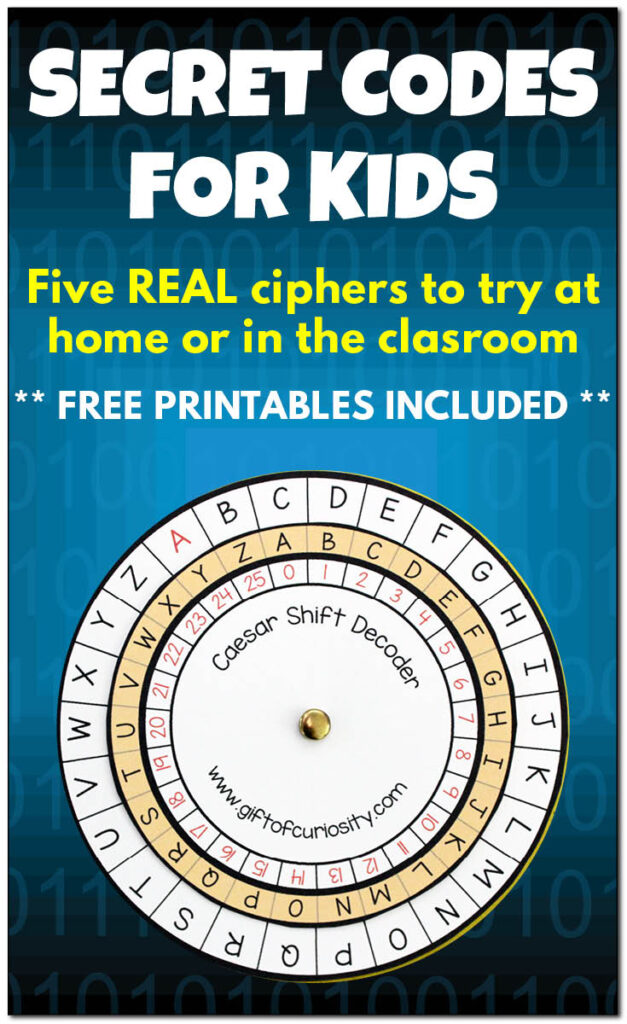
A brief history of cryptography
Cryptography is the use of codes and ciphers to keep information secret. There are records showing cryptography has been used for thousands of years.
Historically, cryptography methods primarily involved the use of pen and paper encryption or simple mechanical aids. For example, clay tablets found in Mesopotamia dating from 1500 BC had an encrypted recipe for pottery glaze. And Hebrew scholars were using substitution ciphers as far back as 500 or 600 BC.
In modern times, the ability to send encrypted messages has been of vital importance during war efforts. For example, the US recruited and trained Navajo "code talkers" during World War II. These code talkers created a code using their native Navajo language, contributing to the US war effort against the axis forces by allowing secret messages to be relayed. (You can translate your text into Navajo code using this text to Navajo Code translator.)

With the advent of modern computing, more sophisticated and efficient means of encryption have been developed. Current day cryptography relies on such sophisticated and elaborate encryption schemes that they are largely unsuited to pen and paper anymore and must be solved by machine.
Codes vs. Ciphers
Cryptography uses both codes and ciphers. But what is the difference?
Codes are based on semantics, or the meaning of language. An example of code used by the Navajo code talkers for the word "plane" is "wo-tah-de-ne-ih." (If interested, check out the entire Navajo Code Talker's dictionary as well.)
In contrast to codes, ciphers are based on syntax, or symbols. Ciphers are typically just a set of instructions (an algorithm) for converting one set of symbols (e.g., letters) into another set of symbols (e.g., numbers or pictographs). An example of a simple letter-to-number cipher is A=1, B=2, C=3, etc.
All that being said, while codes and ciphers are different, the terms are often used interchangeably. Morse code, for example, it technically a cipher, not a code. Nonetheless it is called Morse code, not Morse cipher.
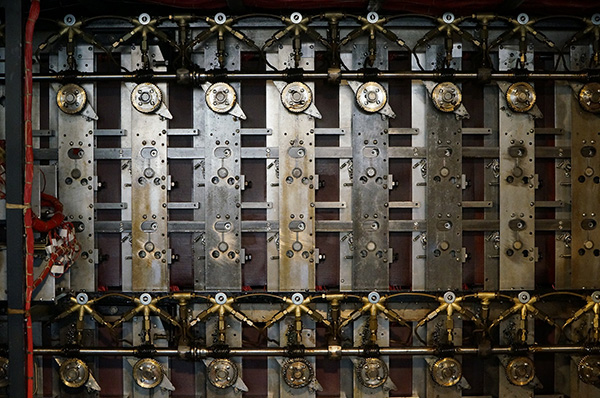
Fun with secret codes for kids
Morse Code
Morse code converts letters and numbers into a series of dots and dashes (sometimes called dits and dahs).
In Morse code, each dash has a duration that is three times as long as each dot. Each dot or dash within a character is followed by period of no signal, called aspace, equal in duration to the dot.
Morse code is well suited to be communicated through sound using audio tones. It can also be communicated visually using flashing lights. Although the code is not designed to be transmitted in written format, it can be written as well.
If you want to play with Morse code, download my free Fun with Morse Code printable. This printable includes a bit of background information about Morse code, an encryption tool to create your own messages in Morse code, and a decoding tool for deciphering messages in Morse code.
Or make things easy on yourself and upgrade to my Codes and Ciphers Fun Pack that includes additional worksheets and activities for kids to practice their Morse code skills.
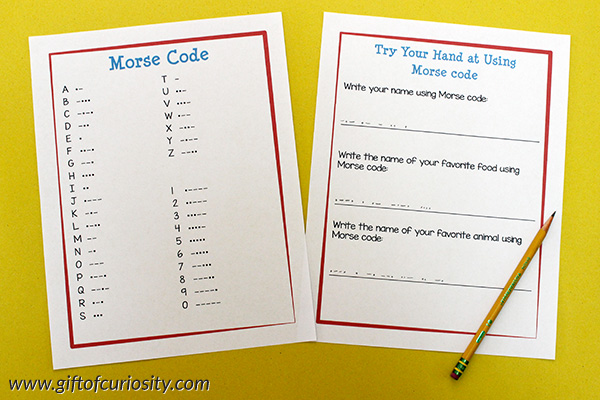
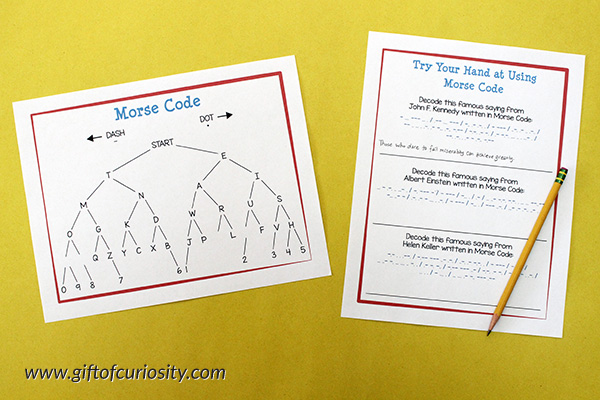
Pigpen Cipher
The Pigpen cipher is a simple but fun substitution cipher. Every letter of the alphabet is paired with a geometric symbol.
If you want to play with the Pigpen cipher, download my free Fun with Pigpen Cipher printable. This printable includes historical information about the Pigpen cipher (do you know there are tombstones with Pigpen symbols?) plus an encryption/decryption tool to create and decipher Pigpen messages.
Or make things easy on yourself and upgrade to my Codes and Ciphers Fun Pack that includes worksheets and activities for kids to practice their Pigpen cipher skills.
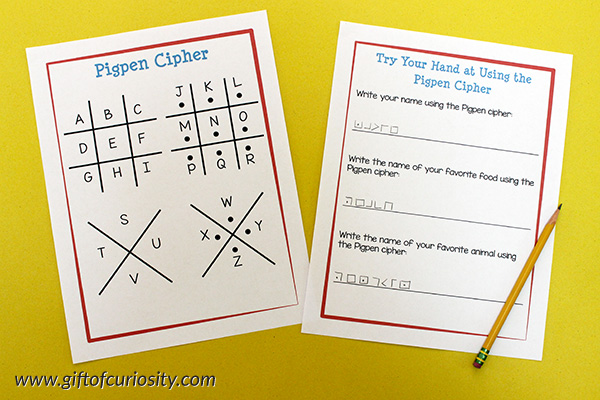
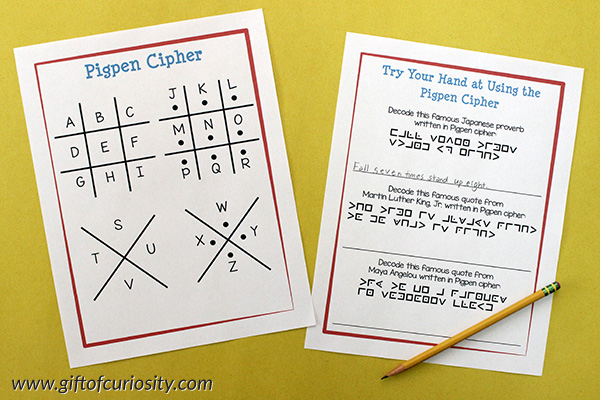
Caesar Shift Cipher
The Caesar Shift cipher is named after Julius Caesar, as he used this cipher to encrypt messages. However, it isn't a very difficult cipher to figure out and thus messages sent with this cipher did not stay secret for very long.
With the Caesar Shift cipher, each letter of the alphabet is "shifted" some fixed number. The shift is named a "ROT," which stands for "rotation."
For example, with a ROT1 shift A becomes B, B becomes C, and so on. With a ROT13 shift, on the other hand, A becomes N, B becomes O, C becomes P, etc.
To decode a message sent using the Caesar Shift cipher the person must be aware what shift has been used.
If you want to play with the Caesar Shift cipher, download my free Fun with Caesar Shift Cipher printable. This printable includes historical information about the Caesar Shift cipher and an encryption/decryption tool to create and decipher Caesar Shift messages.
If you as a parent or teacher wish to create messages in the Caesar Shift cipher for your children or students to decode, you can certainly do them by hand. Or do what I do and use a text to Caesar Shift cipher translator. Be sure to indicate the shift (ROT) you desire for your cipher before encrypting your message.
Or make things easy on yourself and upgrade to my Codes and Ciphers Fun Pack that includes worksheets and and activities for kids to practice their Caesear Shift cipher skills.
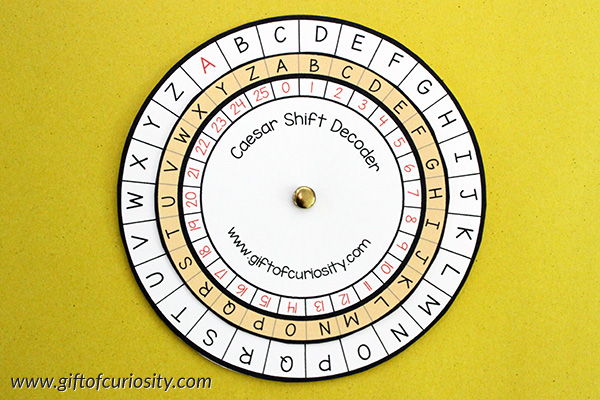
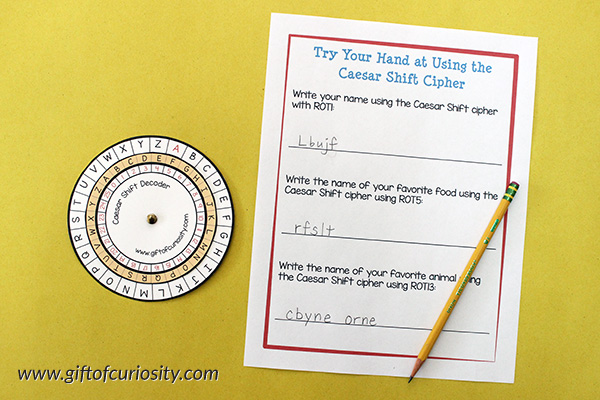
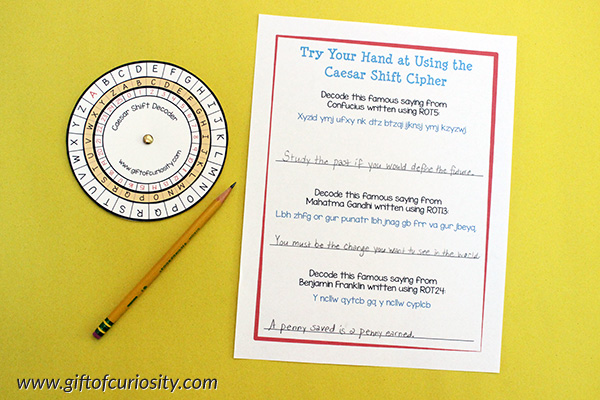
Atbash Cipher
The Atbash cipher is a simple monoalphabetic substitution cipher originally used to encrypt the Hebrew alphabet. With this cipher, we simply take the alphabet and map it to its reverse.
As such, when the Atbash cipher is used in English A becomes Z, B becomes Y, and C becomes X.
If you want to play with the Atbash cipher, download my free Fun with Atbash Cipher printable. This printable includes historical information about the Atbash cipher and an encryption/decryption tool to create and decipher Atbash messages.
If you as a parent or teacher wish to create messages in the Atbash cipher for your children or students to decode, you can certainly do them by hand. Or do what I do and use a text to Atbash cipher translator.
Or make things easy on yourself and upgrade to my Codes and Ciphers Fun Pack that includes worksheets for kids to practice their Atbash cipher skills.
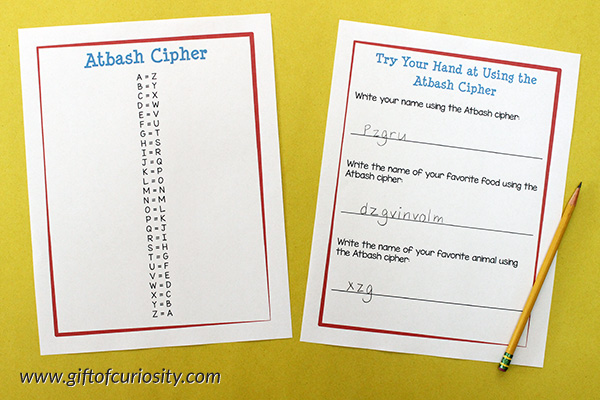
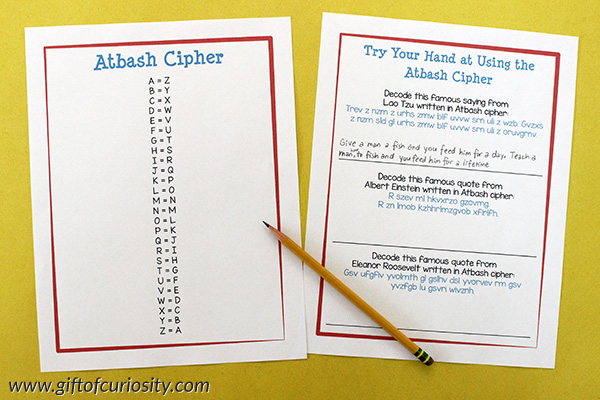
Playfair Cipher
The Playfair cipher is a digraph substitution cipher that is significantly more difficult to decode than any of the single letter substitution codes listed above.
This cipher uses a table with letters arranged in a 5 x 5 grid. (One letter of the alphabet – often the J – is left out and is generally substituted with an I. Pairs of letters are then located on the grid and encoded by shifting right in the case of two letters in the same row, shifting down in the case of two letters in the same column, or shifting to a corresponding corner in the case of two letters forming a rectangle in the grid.
Perhaps the most famous use of the Playfair Cipher was when future president of the United States, John F. Kennedy, used it during World War II to relay a message that his ship had been hit by a Japanese destroyer.
If you want to play with the Playfair cipher, download my free Fun with Playfair Cipher printable. This printable includes historical information about the Playfair cipher and an encryption/decryption tool to create and decipher Playfair messages.
If you as a parent or teacher wish to create messages in the Playfair cipher for your children or students to decode, you can certainly do them by hand. Or do what I do and use a text to Playfair cipher translator.
Or make things easy on yourself and upgrade to my Codes and Ciphers Fun Pack that includes worksheets for kids to practice their Playfair cipher skills.
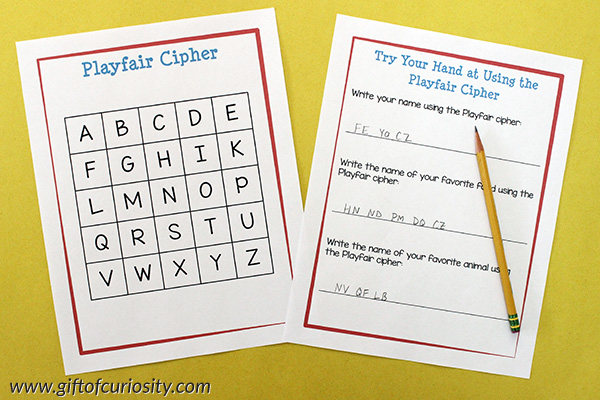
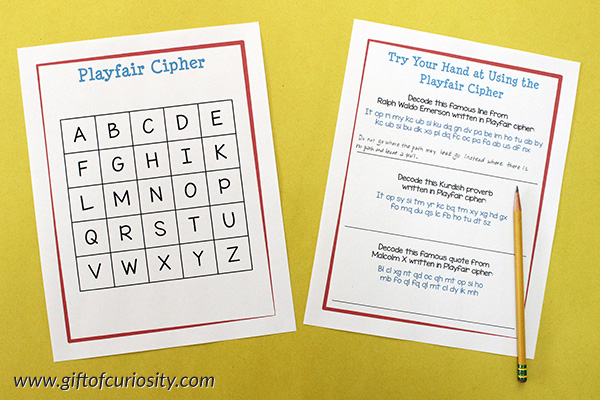
Ready to have fun with codes and ciphers?
Purchase the Codes and Ciphers Fun Pack and get a BONUS Secret Code Scavenger Hunt activity for FREE!
-
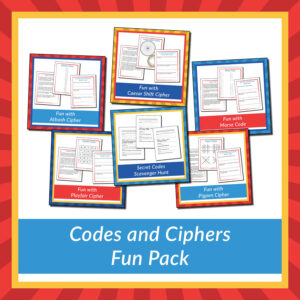
Codes and Ciphers Fun Pack
$3.49
Or get the encryption tools without the extra activities (or the bonus scavenger hunt):
- Fun with Morse Code
- Fun with Pigpen Cipher
- Fun with Caesar Shift Cipher
- Fun with Atbash Cipher
- Fun with Playfair Cipher
Source: https://www.giftofcuriosity.com/secret-codes-for-kids/
0 Response to "Easy Codes That Are Hard to Guess Easy Ciphers That Are Hard to Guess"
Publicar un comentario